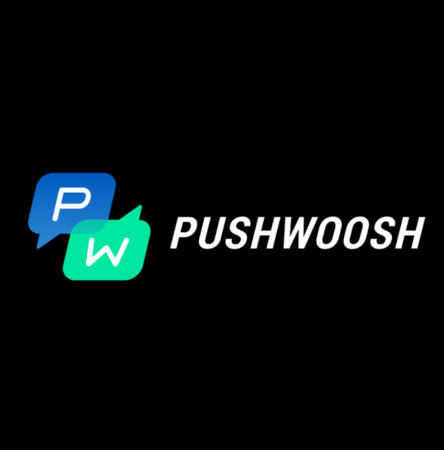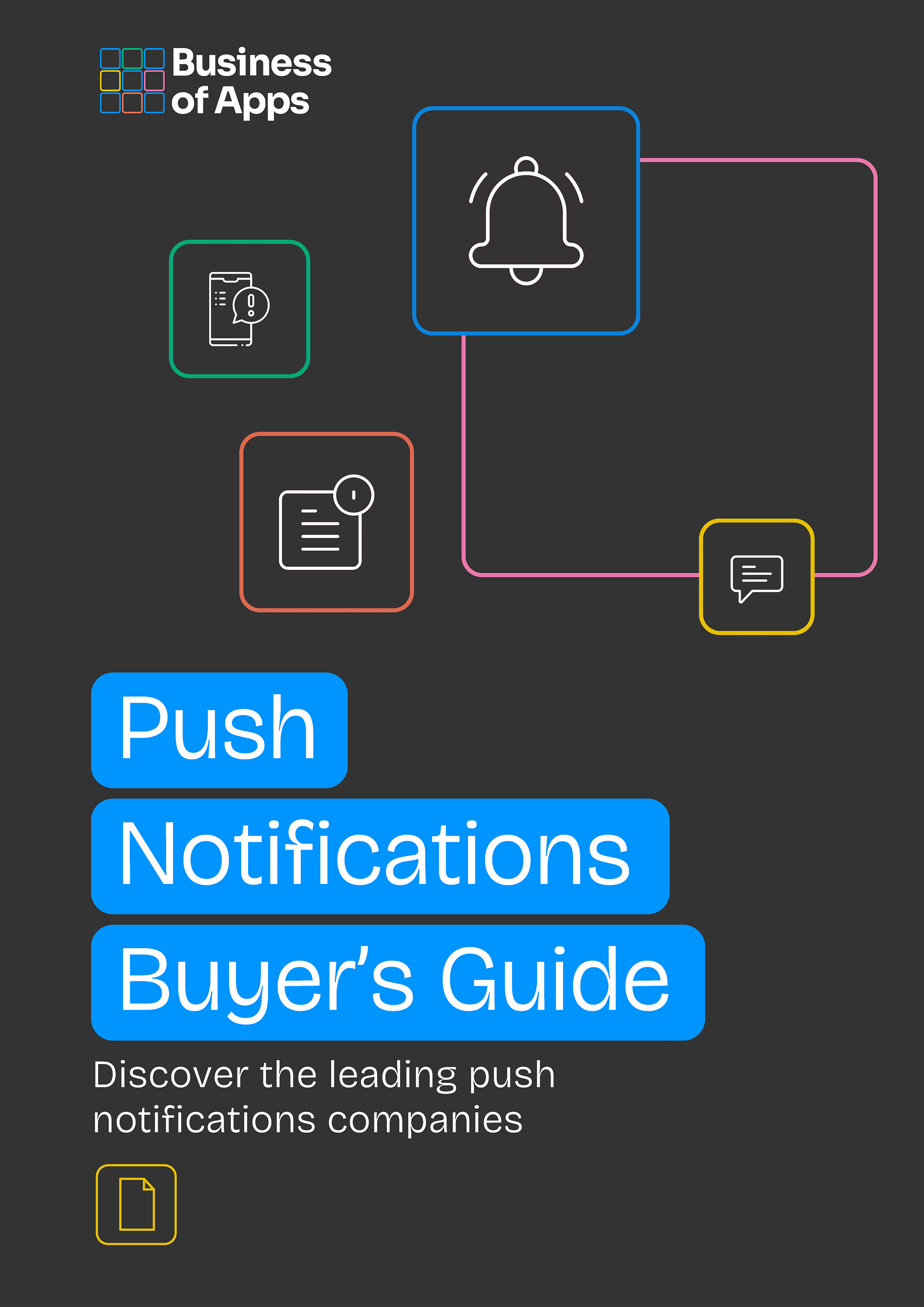This guide will walk you through what an Android push notification is, how they work, and how to choose the best service for you.
An Android push notification is a message that pops up on a mobile device even when a user is not actively using the app. It’s a way for app developers to communicate with their users and provide important information (or other useful reminders).
Push notifications can be customized to include text, images, and sounds to grab a user’s attention, and they’re a great way to keep people informed about updates, new features, or special promotions.
An Android push notification service itself is a feature that enables apps to send push notifications to users’ devices–you can find the best push notification services in our directory below.
Streamline your push notification campaigns
One engine for highly personalized, segmented messages, and analytics
Learn moreWhat is a push notification in Android?
A push notification for Android is the way in which mobile apps send notifications to users’ devices when an app is not being used. These simple notifications can include text, images, and sounds.
They’re a valuable tool for keeping users informed about new updates and any special promotions you want your users to be aware of.
Push Notifications Buyer's Guide
Download our Push Notifications Buyer’s Guide to get a full list of the best service providers on the market to choose from. Also, learn what push notifications are, how to choose a provider, and about main categories of push notifications providers.
The best Android push notification services are easy to use, affordable, often come with a visual builder, and are quick to set up.
The best Android push notification companies
Android push notification services enable businesses to send real-time, personalized notifications to users on Android devices. These platforms offer features such as message segmentation, automation, A/B testing, and detailed analytics to help improve user engagement, retention, and conversions.
Businesses can deliver targeted messages, automate campaigns, track performance, and ensure seamless communication with users, driving more meaningful interactions and enhancing the overall app experience.
We’ve listed the best Android push notification services below.
1. RollerAds

RollerAds is a high-performance ad network with worldwide coverage and over 10 years of experience in affiliate marketing. The platform emphasizes traffic quality through an in-house anti-fraud system and offers features like a creative library and CPA optimization to enhance campaign performance.
RollerAds, as a digital advertising platform, delivers Android push notifications by integrating with its audience targeting and a wide variety of engagement tools.
Overview
RollerAds was founded by CEO Andrey Veselov and is a global advertising network specializing in high-performance ad formats such as Android push notifications, in-page push, OnClick (popunder), and calendar ads.
The platform serves over 32,000 advertisers and collaborates with more than 18,000 direct publishers, delivering approximately 4.5 billion daily impressions and 7 million daily clicks.
Services
RollerAds provides its customers with the following services:
- Built-in fraud detection ensures high-quality traffic and prevents bot activity
- Ensures compliance and optimal ad performance for both publishers and advertisers
- Self-serve platform offers an easy-to-use dashboard for campaign management with real-time analytics
2. Pushwoosh

Pushwoosh is a customer engagement platform that provides Android push notifications and mobile messaging services for businesses. It allows companies to send targeted, automated, and personalized messages via mobile apps, websites, emails, SMS, and in-app messaging to engage users and improve retention.
It offers seamless integrations with CRM systems and analytics platforms, making it a versatile tool for marketers seeking to drive growth and improve their customer experience. With features like A/B testing, real-time analytics, and advanced automation, the platform helps optimize your campaigns and boost conversions.
Overview
Pushwoosh was founded in 2010 by Sergey Laptukhin, a technology entrepreneur. The platform has since been used by companies in various industries, including eCommerce, media, gaming, and SaaS, to engage users through push notifications and other messaging tools.
Notable clients include Viber, Ryanair, Shazam, and Acronis, among others, who leverage Pushwoosh for customer engagement and retention.
Services
Pushwoosh provides its customers with the following services:
- Send real-time notifications to users on mobile devices, websites, and desktops (includes iOS, Android, and web)
- Display messages, banners, or pop-ups within apps to engage users while they’re active on the platform
- Enable businesses to send promotional and transactional messages via SMS and email to enhance reach
3. Airship

Airship (formerly known as Urban Airship) is a customer engagement platform that specializes in providing Android push notification services, in-app messaging, SMS, email, and mobile wallet marketing. It helps businesses engage with users across multiple channels and devices, enabling them to deliver personalized and timely messaging.
Airship is used by a wide range of industries, including retail, finance, travel, and media, to enhance customer engagement, improve retention, and drive conversions.
Overview
Founded in 2009 by Scott Kveton, Brett Caine, and Chris Warner, Airship is a customer engagement platform that helps businesses deliver personalized messaging across multiple channels, including push notifications, in-app messaging, SMS, email, and mobile wallets.
The company has worked with a range of well-known clients, including McDonald’s, eBay, Nike, The New York Times, and Domino’s, to enhance customer engagement, retention, and conversions through targeted, automated messaging campaigns.
Services
Airship provides its customers with the following services:
- Run targeted email campaigns to nurture customer relationships and promote special offers or updates
- Send digital passes, loyalty cards, or tickets directly to customers’ mobile wallets, enhancing brand presence and customer loyalty
- Segment your audience based on behaviour, location, demographics, or preferences to deliver relevant and effective messaging
4. Pusher Beams

Pusher Beams is a real-time Android push notification service designed for developers to easily send notifications to users across mobile and web apps. It focuses on delivering reliable, high-performance push notifications with minimal setup and management.
Pusher Beams enables businesses to send personalized messages to users, including rich media notifications, with a focus on improving user engagement and retention.
Overview
Pusher Beams is a product of Pusher, a company founded in 2011 by Max Williams and Ian Firth. Pusher Beams, launched as part of Pusher’s suite of real-time communication tools, focuses on push notifications to help developers send reliable, personalized messages to users across mobile and web platforms.
It’s used by companies like Domino’s, The Financial Times, and Deliveroo to engage and retain users through real-time notifications, enhancing the customer experience and driving user retention.
Services
Pusher Beams provides its customers with the following services:
- Target specific user groups based on behaviour, preferences, or other attributes to deliver personalized notifications
- Send notifications that include images, videos, or other media to enhance user engagement
- Deliver push notifications seamlessly across multiple platforms, including mobile and desktop apps
5. Leanplum

Leanplum is a mobile engagement and personalization platform that helps businesses deliver targeted messages and personalized experiences to users through mobile apps and other channels. With features like A/B testing, Android push notifications, in-app messaging, and user segmentation, Leanplum enables companies to optimize user engagement, increase conversions, and improve customer retention.
One of Leanplum’s core offerings is its push notification service, allowing businesses to send personalized notifications directly to users’ mobile devices. This helps keep users engaged, informed, and more likely to take action, whether it’s a promotion, reminder, or update.
Overview
Leanplum was founded in 2012 by Arvind Jain and Arjun Kumar with the goal of helping businesses optimize mobile engagement and improve customer experiences through personalized content and messaging.
The platform has served a variety of clients across industries such as eCommerce, gaming, media, and SaaS, with notable companies like Peach, Hershey’s, Domino’s, Groupon, and The New York Times using its tools for A/B testing, push notifications, and in-app messaging to boost user engagement and retention.
Services
Leanplum provides its customers with the following services:
- Deliver customized content, promotions, and experiences based on individual user behaviour and preferences
- Automate messaging and campaigns based on user actions, such as in-app behaviour, purchases, or sign-ups, to maintain user engagement without manual intervention
- Engage users through multiple channels, including push notifications, in-app messages, SMS, and email, to create a consistent cross-channel experience
6. AdMaven

AdMaven is an ad network that offers a wide range of advertising solutions for both publishers and advertisers, focusing on high performance, monetization, and user engagement.
It provides tools for driving traffic and revenue through various ad formats, including push notifications, pop-unders, display ads, interstitials, and native ads. AdMaven delivers targeted and engaging ads to users, helping advertisers reach their audience and publishers maximize their earnings.
AdMaven also offers an Android push notification service to send real-time, personalized notifications directly to users’ browsers or mobile devices, increasing user engagement.
Overview
AdMaven was founded in 2013 by Shlomi Shani and a team of digital advertising experts. The platform focuses on providing diverse advertising solutions to publishers and advertisers, helping them maximize revenue and engagement.
AdMaven serves a wide range of clients across various industries, including eCommerce, gaming, and mobile apps, with notable companies using the platform to optimize their advertising campaigns through formats such as push notifications, pop-unders, and interstitial ads.
Services
AdMaven provides its customers with the following services:
- Send personalized, real-time push notifications to Android users’ devices, enabling businesses to keep users engaged with timely updates, offers, or promotions
- Target specific Android user segments based on behaviour, demographics, or device information to ensure push notifications are relevant and personalized
- Automate push notification campaigns, sending messages triggered by specific actions such as app installations, user behaviour, or events within the app
7. PropellerAds

PropellerAds is a global ad network that provides a range of advertising solutions for both advertisers and publishers. It specializes in offering various ad formats, such as display ads, native ads, Android push notifications, pop-unders, and interstitials, designed to maximize engagement and revenue.
For push notifications to be delivered, users need to opt-in to receive them. The platform provides tools for publishers and advertisers to prompt users to subscribe to push notifications, ensuring that the messages are sent only to those who have agreed to receive them.
Overview
PropellerAds was founded in 2011 by Alex Vasekin and a team of digital advertising experts to provide high-performance advertising solutions to help businesses grow their reach and revenue.
The platform serves a wide range of clients across various industries, including eCommerce, mobile apps, gaming, and media.
Services
PropellerAds provides its customers with the following services:
- Enables advertisers to send real-time push notifications to Android devices, delivering timely and relevant messages to users, even when they are not actively using the app
- Audience segmentation based on user behaviour, location, device type, and other factors, ensuring push notifications are personalized and reach the right users
- Supports rich media push notifications that include images, videos, and interactive elements, making the messages more engaging and visually appealing to Android users
Types of push notifications in Android
There are different types of push notifications available on Android devices. These notifications can be categorized into the following main groups:
- Transactional notifications–These push notifications are sent to customers to inform them of the status of a transaction; for instance, when they make a payment.
- Marketing/promotional notifications–These are the type of push notifications that online retailers use to send exclusive offers, deals, and giveaways to customers.
Push notification providers themselves have been around for a while, (some for over a decade). Amassing a huge amount of expertise, a push notification service can make it easier to plan, schedule, and deploy messaging to users.
What are the best practices for Android push notifications?
Here are some best practices you can employ for Android push notifications that can help ensure a positive user experience for your users.
Personalization
This is where you make use of personalization whenever possible to make push notifications feel more individual to each customer. This boosts the chance of the customer interacting with your message.
Accuracy
You should only send Android push notifications that are relevant and valuable to the user.
Avoid sending too many notifications, as this can be overwhelming and lead to users disabling notifications altogether; they’re unlikely to go back on their decision.
Timing
Be sure to send push notifications at the appropriate time, such as when the user is most likely to be using the app or when a time-sensitive special event is occurring.
Android push notification service example

Source: OneSignal
Consistency
Keep your Android push notifications short and to the point, and make sure the message is easy to understand.
Be consistent with your messages and times, and users will, in turn, reward you with their loyalty.
Use a variety of media
Consider using a variety of media, such as images, videos, or GIFs, that make the notifications more engaging and visually appealing.
Be sure the media is relevant to the message and doesn’t slow down the notification delivery.
A/B testing
Use A/B testing to improve your push notifications. By creating two versions of your notification and sending them to different groups, you can analyze the data to determine which one had a higher click-through, open, and conversion rate.
This information can help you optimize your messages and ultimately drive more results.
Remember to follow the best practices mentioned to ensure a positive user experience.
Why should you use push notifications in Android?
Push notifications on Android can be a powerful tool to keep your users engaged (and informed) about important updates, promotions, and new features.
They can be personalized and targeted to specific audiences, significantly increasing the chances of both conversion and app retention; they’re more than worth using.
Below we’ve listed the key reasons why you should use them.
Higher engagement
Mobile users are more likely to return to a mobile app that consistently delivers relevant and timely notifications. Executed correctly, push notifications can dramatically improve your engagement and conversion rate.
Boost message visibility
By sending real-time updates and personalized reminders, push notifications can help ensure that your messages are seen and acted upon. By providing timely and relevant content, you can improve user engagement and encourage users to return to your app.
Push notifications are a helpful tool for boosting message visibility and enhancing the user experience.
Drive customer retention
Using personalized reminders and real-time updates, push notifications are able to assist you in ensuring that customers stay engaged with your brand.
You can improve both user engagement and encourage customers to continue using your services or products. Push notifications are a valuable strategy for increasing customer retention.
Android push notification service example
 Source: WonderPush
Source: WonderPush
Increase conversions
Sending targeted and personalized notifications to your users reminds them of new products, special promotions, and encourages them to come back to your app.
It’s a great way to keep your brand at the top of their mind and boost conversions.
Enhance UX
Using Android push notifications will not only increase your conversions, but it’ll also create a more engaging and interactive experience for your mobile customers all around.
When optimized, push notifications can enhance user engagement, increase retention, and drive conversions.
Leverage cross-channel communication
You can take your push notifications to the next level by leveraging all important cross-channel communication.
Doing this ensures that your customers receive notifications through multiple different channels–this helps you to reach a wider audience and keep your brand on their minds no matter where your customers are.
Cross-channel communication will allow you to personalize your notifications further based on the specific channel you’re using.
How to enable push notifications on Android?
To set up push notifications for your app using Firebase Cloud Messaging, you’ll need to do the following:
- Start by creating a Firebase project and adding your Android app to it
- Next, add the Firebase SDK to your app
- Create a “FirebaseMessagingService” class and register it in your “AndroidManifest.xml” file to set up Firebase Cloud Messaging in your app
- Use the “FirebaseMessaging.getInstance().getToken()” method to obtain a device token for the user’s device
- Finally, use the token you obtained to send push notifications to a user’s device through the Firebase Cloud Messaging API
Of course, there are pros and cons to using Firebase Cloud Messaging for push notifications. We’ve listed the main ones below for you.
Pros
- It’s a free service provided by Google, which makes it a cost-effective option for small businesses or developers on a tight budget
- It offers a high delivery rate for app developers
- It can handle large volumes of notifications at once
Cons
- Firebase requires some technical expertise to set up and integrate with an app
- There may be occasional delays or issues with delivery
Overall, it’s important to carefully weigh up the pros and cons before deciding if Firebase Cloud Messaging is the right choice for you.
Alternatively, to set up push notifications using Expo (an open-source codebase for iOS, Android, and the web), follow the steps below:
- First, make sure you have the Expo client installed on your device
- Follow the Expo documentation to configure your app to receive push notifications
- Inside, you’ll need to create a push notification service
- From there, register your app with the Expo push notification service
- Once you’ve completed the aforementioned steps, you can start sending push notifications to your users
Don’t forget to customize your notifications and track your metrics to optimize your engagement strategy over time.
There are, naturally, pros and cons to using Expo. We’ve listed them for you below:
Pros
- Expo provides a streamlined app development process
- It allows you to easily configure and test your app on multiple devices
- It includes built-in features, including in-app purchases and analytics
Cons
- Some potential cons include the limited customization options (how important this is for you will vary)
- There’s less control over the app’s performance
When deciding whether to use Expo for your app development, be sure to carefully weigh up the pros and cons.
Android push notification examples
Below you can find examples of Android transactional and promotional push notifications.
Transactional push notifications
The first example shows DoorDash informing the customer about the status of their food order:

Source: DoorDash
The second example shows MoStore informing a customer that their order has been canceled:

Source: MoStore
Promotional push notifications
The first example shows an Instagram reminder push notification in action:

Source: Instagram
The second example shows TGI Fridays offering free delivery Friday-Sunday:

Source: TGI Fridays
Both types of Android push notifications have their uses–app developers will need to deploy them skillfully.
Work with top push notification services for Android
Push notifications are an essential component of many apps, and using a top push notification service for Android can offer a wide range of benefits.
Push notifications help to improve user engagement, app retention and allow you to target specific groups of users with tailored messages. A high-quality push notification service can also help to avoid issues such as messages being delayed or not arriving at all.
Overall, using a top push notification service is a smart choice for any Android app developer looking to optimize their user experience and take their app to the next level.











